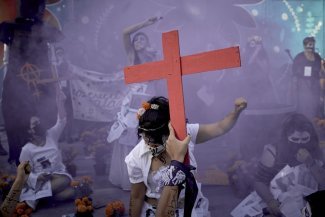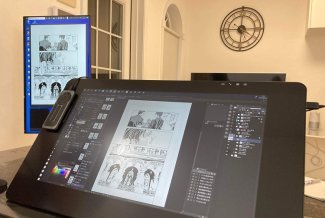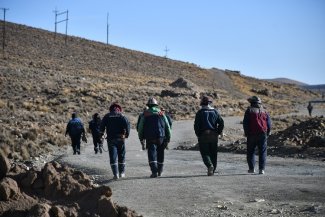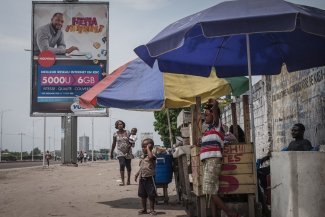An ELN guerrilla on the ‘Che Guevara’ Front in the Chocó department, Colombia, takes part in the moring line up. Most combatants use a scarf to cover their faces and avoid being identified in case they return to civilian life. Of the hundred insurgents on this western front, half are indigenous and the other half are of African descent.
In the ranks of the National Liberation Army (Ejército de Liberación Nacional, or ELN), Colombia’s principal guerrilla group since the demobilisation of the FARC, peace is just an illusion. The temporary cease in hostilities, a truce that lasted 101 days – from 1 October 2017 to 9 January 2018 – had no real effect.
In response to ten attacks by the ELN since the beginning of 2018 the Colombian government has suspended the dialogue that began a year ago and resumed military action with bombardments. Members of the ELN’s Omar Gómez Western Front, in the Chocó department on the Pacific coast, never abandoned arms, as Equal Times discovered.
“We were training and getting prepared to carry on. Because when the ceasefire ends, the government is going to come back in full force. We have to be ready for the war that’s coming our way,” said Natalia (not her real name) at the end of last year.
The escalated conflict resumed at dawn on 9 January 2018, just two hours after the end of the bilateral ceasefire that lasted barely three months. The rebels ambushed two marines in Arauca (in the north, on the border with Venezuela) with grenades, killing one of them, and detonated several explosives in Casanare (centre-east of the country). President Juan Manuel Santos promptly suspended the start of the fifth round of negotiations due to take place in Quito, Ecuador.
Two weeks later, a triple attack in Santa Rosa, Soledad and Barranquilla - in the centre-west and north, the latter the most serious, on a police station, which left five soldiers dead and more than 40 injured - forced the government to suspend talks with the rebels.
Despite these attacks, members of the ELN delegation in Quito have insisted all the times that negotiations should resume and assured Equal Times that they were not even aware of the attacks, and more specifically the Barranquilla attack, which an urban militia claimed responsibility for. This disconnect between the troops and their representatives has completely undermined the government’s confidence in the credibility of its negotiators.
Santos himself refused to resume the talks because there was “no coherence between the ELN’s words and its actions”. The anarchic structure of this guerrilla group has led to a contradiction between its official position and its actions on the ground.
On Tuesday this week, and with the legislative elections of 11 March in the background, this guerrilla announced a unilateral ceasefire of offensive military operations for a few days before and after the polls: from 9 to 13 March.
On the western front, the truce allowed them to abandon their routine of constantly moving on to flee the bombings. However, they took advantage of this period of calm to do physical training and military manoeuvres every morning, as well as to make homemade explosives with large balls of gunpowder and gas cylinders, another sign of the scepticism about the process among these 100 or so eleno guerrillas (as denominates the members of the ELN) assembled in the village of Noanamá in Chocó.
The ceasefire “was ready to collapse at any moment,” according to Uriel (an alias) the camp’s commanding officer.
Most of the incidents with the armed forces were concentrated on this front during the ceasefire. The elenos, for example, denounced the ‘harassment’ (or even ‘provocation’) by the army - with troops disembarking nearby, the deployment of helicopters and, amongst others, the eradication of coca crops - in the areas that they consider ‘theirs’ - and during our stay in the camp we witnessed how two army helicopters deployed a group of soldiers to manually fumigate a plantation just three kilometres away from the guerrilla settlement.
The government has in turn accused the Front of violating the ceasefire on several occasions. One of the most serious was the murder of an indigenous leader. Some 35 incidents throughout the country have been presented by the ELN and the government to the UN Monitoring Mechanism so far. The fragile compliance with and verification of the ceasefire has deepened the suspicions of the guerrillas regarding a peace process that started with serious misgivings and is progressing extremely slowly. After almost a year of talks they have not yet got beyond the first item on the agenda, the participation of Colombian society as a whole, one of the most ambitious prerequisites of the ELN and which the government sees as an obstacle owing to the difficulty of achieving it.
For political analyst Víctor de Currea, both sides have made the mistake of “not having a strategy, which means they are negotiating without a clear goal in mind”. Add to this the fact that the current government only has a few months left (presidential elections are due to be held at the end of May), the process, he believes, is on the verge of collapse.
“The ELN has tried to make everything bilateral and has not agreed to make a unilateral gesture. Now the government says it will come back to talks if they can first talk about a new ceasefire before, while the ELN insists that they sit down to negotiate first and then talk about a possible ceasefire. There is a lot of stubbornness and lack of political skill,” he explains.
The agreement with the FARC: an unconvincing example
“Peace has become a dirty word in Colombia. Peace means no poverty, [that] there is equality. Until that happens, here we would not dream about laying down our arms,” said Estasio, one of the subcomandantes who was the most distrustful in our presence.
“If the problems are not solved, I will put down my rifle today, but tomorrow someone else will take it,” said the young man matter-of-factly.
Similarly, most of the guerrillas believe that “the FARC surrendered” by handing over its weapons without achieving “the justice they were fighting for”. The slow implementation of the peace accords with the FARC has multiplied the ELN’s distrust of its own process.
In a year since the signing of a peace agreement between the parties, there has only been progress on 18.3 per cent of the agreement, according to a report by the Monitoring Observatory for the Implementation of the Peace Agreement (OIAP) published at the beginning of January.
The FARC is critical of the delay in the approval of laws and their amendment in Congress in line with the agreement. “If the government had complied with the FARC, we would have that example, but today we see something different, so we cannot trust them or lower our guard,” said Andrés, another of the guerrillas.
That distrust, together with the weak ceasefire and a minimal de-escalation of the conflict, lowered the expectations of both parties faced with a crumbling peace process. Despite the truce, the ELN has continued its criminal activities such as kidnapping and extortion. One of the subcomandantes, Yerson, admitted these practices were their main source of income. “This war also has to be financed,” he explained. During the ceasefire, 11 guerrillas kidnapped 21 civilians (19 have already been released), according to the Resource Centre for Conflict Analysis (Cerac).
The ELN freed former congressman Odín Sánchez in February 2017 along the Noanamá path. It was the government’s principal demand before it would start the public phase of the talks, which started the week after his release, after a year of delays. The politician himself, held captive for ten months, described the shores of the San Juan River as the “fourth world”, where people lived in “inhumane” conditions.
Conflict continues in the poorest region of the country
Sixty per cent of the population lives below the poverty line in Chocó, historically the country’s most neglected and poorest department. Along the riverside paths of the San Juan River, many families, most of them of African descent, were forced to leave their homes at the beginning of 2000 due to the incessant fumigations that devastated the coca crops, which only added to the non-viability of the agriculture on the swampy land and to the fall of the price of gold. Now, those who remain make a living from felling trees. And the uninhabited barracks are again occupied - by the eleno guerrillas, who justified their struggle by the need to help their neighbours out of abject poverty and defend them from the dispossession of their lands.
“As long as there is poverty, there will be guerrillas. We will be here and above all in this region because it is a population that has been so badly affected throughout history,” said Estasio.
Similarly, in the last year several communities have been forced to move because of clashes between the ELN and successive paramilitary groups that have tried to fill the space left by the FARC after its demobilisation. Commander Uriel categorically denied that they had taken advantage of the FARC’s withdrawal to expand their territories: “This is the culmination of a four-year expansion process and it has coincided with that context, but it is not intentional.”
The truce was agreed with the government, but the war continued against other groups. According to data from the Ombudsman’s Office, which Equal Times was able to access, in Chocó there were 19 mass displacements during the past year (with a total of 5,659 displaced people), 44 per cent of the total for the entire territory.
Added that were the 11,314 people still confined (without freedom of movement to prevent any armed group), 77 per cent of the total in Colombia. In Noanamá the locals waivered between empathy and resignation at the guerrilla presence.
Every six days at most, for security reasons, the front moves to another path. At that time, the rebels are busy loading up the backpacks, chairs and washing machines onto the boats at dusk. In the most rainy and humid region of the country any transport has to be along the infinite number of waterways - with access to the sea, a geographical advantage that makes this department one of the most coveted by drug traffickers, since it allows them to easily hide the transport of their goods.
In the middle of all this frantic activity, a mother runs after her three-year-old daughter. She was reunited with her thanks to the ceasefire, but is willing to part again. “It is a huge sacrifice,” Nayer says between sobs, “but I do not want a peace that only benefits me, but all the people.”
Twelve hours after Santos announced the suspension of the talks on 29 January 2018, the army bombed a path of the San Juan River coast, just a few kilometres from where Equal Times visited the ‘Che Guevara front’ the attack was aimed at.
One of the targets was Subcommander Eresio. In the operation, the authorities captured four guerrillas and allegedly wounded a civilian minor, although unofficially it is said there were several casualties. Some 700 indigenous people from that region have had to move.
“Terrorism is being fought with full force as if there were no peace negotiations, and they negotiate as if there were no terrorism,” Santos said after the bombing, something that the government had not done since September of last year, just before the ceasefire. The conflict in Colombia is intensifying against the only active guerrilla group, and the options for peace options are running out.










